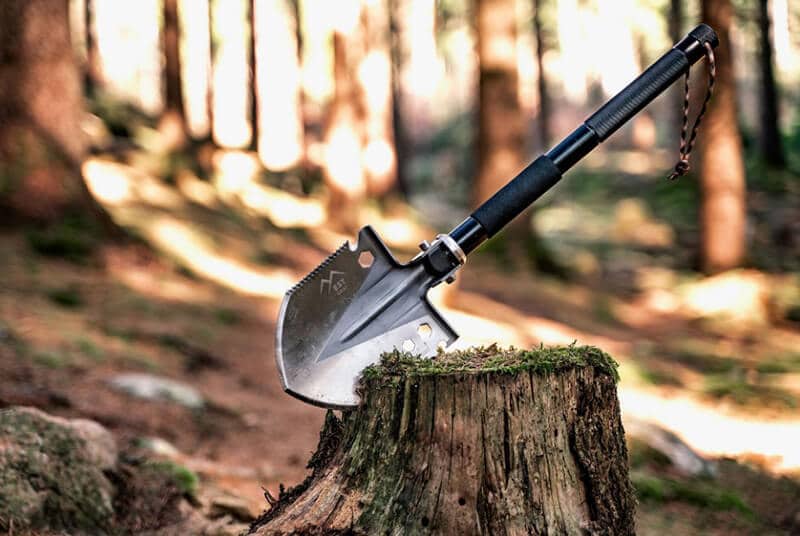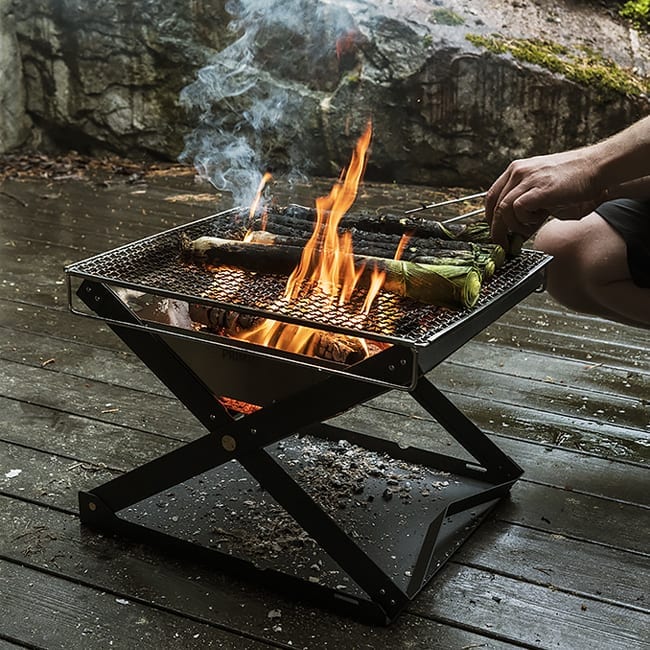Heading out on a primitive camping trip and wondering what you’re getting yourself into?
You’re not alone.
Deciphering precisely what all that camping jargon means can be tricky, which is why we’ve created this guide to everything you need to know about primitive camping.
Coming up, we’ll talk about the ins and outs of primitive camping and we’ll even provide you with some top tips to help you make the most of your future adventures.
Page Contents
What is primitive camping?
Primitive camping refers to either camping in a campground that has few amenities (e.g., no hookups, picnic tables, or running water) or it can refer to backcountry camping.
Primitive camping is simply any type of camping that forgoes the luxuries that campers enjoy when they stay in an RV or at a developed camping area.
Many people use the phrase primitive camping or wild camping to refer to backpacking or any other type of dispersed camping that happens away from the road.
However, if you’re searching for campgrounds online, you’ll certainly come across a few that label themselves as primitive campgrounds. In these situations, you should expect to have very basic amenities, if any at all.
Why you should primitive camp?
When compared to camping in a developed campground with plenty of modern amenities, primitive camping might not seem like the best way to get outside.
However, nothing could be further from the truth. There are many benefits to primitive camping, whether that’s in a campground or in the backcountry.
Here are some reasons why you should primitive camp.
Added solitude
Developed camping areas with loads of amenities tend to be quite busy places. Depending on your personal camping style, you may enjoy the bustle of a busy campground, but if you’re looking for some solitude in the mountains, a primitive camping trip is a sure bet.
Indeed, you’ll often find fewer people at primitive campgrounds than at well-developed alternatives. Plus, primitive backcountry camping allows you to access some very remote places with lots of peace and quiet.
Affordability
Modern full hookup campsites can cost you a pretty penny, especially in popular camping areas like Grand Teton National Park. While you’ll often have to pay a fee to camp in a primitive campground, it’s usually quite a bit less than what you’d pay in a developed area.
On the flip side, even if you need to pay for a backcountry primitive camping permit, it’ll likely be just a fraction of the price you’d pay to car camp.
Feelings of accomplishment
Since primitive camping requires a high level of self-sufficiency, many folks find that they feel quite a sense of accomplishment at the end of their camping trip.
You may also find that going primitive camping helps you develop some confidence in your own personal backcountry and outdoor skills, which will serve you well as you seek out more remote terrain.
Less red tape
Although you may have to get a permit or make a reservation for a primitive campsite, you’ll generally find that it’s easier to snag a place to stay when you’re primitive camping than when you’re staying in a developed campground.
That’s because there’s simply less competition for sites in primitive campgrounds and because you can often camp anywhere you’d like in the backcountry.
As a result, primitive camping trips are perfect for folks who don’t like the hassle of making reservations way ahead of time or for anyone that’s planning a last-minute adventure.
Where can I primitive camp?
One of the best aspects of primitive camping is that you can do it nearly anywhere. In fact, so long as your favorite park, forest, or recreation area allows backcountry camping or if there’s a basic campground nearby, primitive camping is a possibility for your adventures.
In the United States, some of the best places to primitive camp include the Bureau of Land Management (BLM) land and US Forest Service land.
BLM land
For the most part, primitive camping is allowed on BLM land (they usually call it dispersed camping), so long as you limit your stay at a single site to 14 days within a 28 day period.
Many BLM campgrounds are also fairly primitive, so they can be a nice place to stay if you’re looking for an affordable campsite that’s off the beaten path.
Read More :
US National forests
Primitive camping on US national forests is usually quite straightforward as the vast majority of national forests allow you to primitive camp more or less wherever you want, so long as you’re 200 feet (60m) from roads, trails, and water.
However, some more popular national forests have a permit process for primitive camping in certain areas.
National parks
If you’re looking to go primitive camping in a national park, you certainly have options, but they may be more limited than what you’d find in a national forest or on BLM land. National Parks tend to be much more regulated than other public lands in the US, so primitive camping generally requires a permit (though some parks offer free permits).
Depending on the park you’re visiting, you may be able to primitive camp wherever you’d like within a specific area, while other parks require that you stay at a specific primitive campsite.
With that in mind, here are some of the best places to primitive camp in US national parks :
- Rocky Mountain National Park is a hub for primitive camping in the US. The park offers permits for its hundreds of backcountry primitive campsites, though it’s important to note that these sites can get quite popular in the summer.
- Olympic National Park. Primitive camping in Olympic National Park’s backcountry is truly a fantastic experience. You’ll need to get a permit ahead of time, but your permit is the key to accessing some of the park’s most stunning landscapes.
- Yosemite National Park. Although most of the park’s visitors stick to Yosemite Valley, if you’re looking to get away from the crowds, the 750 miles (1,200km) of trails and innumerable primitive campsites in Yosemite’s wilderness areas are the perfect destination.
How to pick the ideal primitive campsite?
Picking an ideal primitive campsite starts with understanding whether you’d like to stay at a front-country primitive campground or if you’re looking to go on a more remote adventure.
For folks looking to stay at a primitive campground, BLM and US Forest Service Lands are usually your best bet. While you can find some primitive campgrounds in US National Parks, these are the exception rather than the rule.
Meanwhile, anyone looking to go primitive camping in the backcountry will need to be confident in their backcountry campsite selection abilities.
Here are some tips to help you choose the right spot :
- Have a destination in mind. Unless you’re keen for a bit of a wander in the backcountry, your first task when selecting a primitive campsite is to have a primary destination in mind. This could be a peak, a waterfall, a lake, or any other point of interest. Once you have a site in mind, then you can start to do a deeper dive to figure out what your camping options are.
- Opt for a site near the water. Although regulations usually dictate that you have to camp at least 200 feet (60m) from water in the backcountry, finding a spot near a water source is usually a good bet. That way you always have access to water for drinking and cleaning while you’re outside.
- Understand your permit requirements. If you need to get a permit for your camping trip, you’ll have to figure out if you’re required to camp in a specific tent site or just in a general area. The regulations surrounding your stay will have a big impact on what campsites you can choose.
- Make safety a priority. There are some truly stunning primitive campsites out there, but not all are safe places to spend the night. When selecting a campsite, avoid locations where there are overhanging dead trees or a high chance of rockfall as these can be serious hazards at night.
What are the must-brings for primitive camping?
Primitive camping requires a high level of self-sufficiency to ensure that you have an enjoyable experience.
Here are some key pieces of gear that you should bring on all primitive camping trips :
- Tent. A 2 person tent (or whatever size is best for your group) is a must-have item because it serves as your shelter while outside.
- Sleeping bag. You’ll need a sleeping bag that’s warm enough for the conditions you expect to face at night.
- First aid kit. Primitive camping takes you far away from medical care, so having a first aid kit is essential.
- Firestarters. If campfires are allowed in your camping area, a set of firestarters are a must.
- Survival gear. Just in case things go awry while you camp, outdoor survival gear can help you thrive in harsh environments.
- Rain jacket. Staying dry can be a challenge while primitive camping, so a quality rain jacket is critical.
- Headlamp. A headlamp is a critical piece of gear if you want to be able to do camp chores at night.
- Stoves. Even if you have a campfire, stoves make cooking up gourmet meals much easier while outside.
Read More : 11 Must-Haves for Primitive Camping
Tips for an enjoyable primitive camping experience
Primitive camping can be an amazing experience, but it’s essential that you come prepared with the right gear and know-how for your trip.
Here are some top tips to keep in mind to ensure you have a great time outside.
- Follow leave no trace. Leave No Trace is an organization that tries to help people enjoy the outdoors in the most environmentally responsible manner. Following their guidelines while camping can help ensure that our favorite outdoor destinations stay beautiful for years to come.
- Always plan for bad weather. Even if the forecast looks great before you leave home, always pack rain gear and warm clothing, just in case. The weather is fickle in the backcountry and you don’t want to get caught outside without the right gear.
- Don’t rely on cell phones. Smartphones are great tools, but they’re not ideal in a primitive camping environment. You often won’t have cell service while primitive camping and, even if you do, it’ll be slow and unreliable. Phones are also known to break easily in the outdoors, so consider using walkie-talkies or satellite communication devices, instead.
- Understand permit regulations. Every land manager has different rules regarding primitive camping permits, so it’s critical that you understand the restrictions on your permit before you leave home. When in doubt, contact a local ranger for more advice.
- Have a method to get water. If you’re staying at a primitive campground, you may or may not have access to tap water. Should tap water be unavailable, you’ll need an alternative method for getting water. This could involve bringing your own water to the campground or using a water filtration system to remove any potentially harmful bacteria from your drinking water. The same advice is relevant to folks going primitive camping in the backcountry. However, backpackers often rely more on purifying your water from lakes and rivers than on carrying large amounts of water into the mountains.
Gaby Pilson
Gaby is a professional mountain guide with a master’s degree in outdoor education. She works primarily in the polar regions as an expedition guide, though she can be found hiking, climbing, skiing, sailing, or paddling in some of the world’s most amazing places when not at work.


